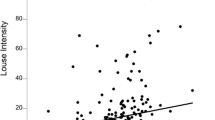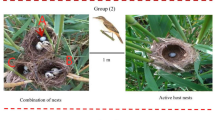Abstract
Chewing lice of the species Docophorulus coarctatus were extracted from museum specimens of their host, the great grey shrike Lanius excubitor, by combing feathers from 36 freshly shot birds (shot between 1962 and 1974), and samples of ten individual lice (five female, five male) were randomly collected for measurements from each bird. Female lice were bigger than males for all studied measurements (P < 0.001 in all cases), although the size of both sexes obtained from individual hosts was positively correlated. The overall size of lice (derived from a principal components analysis) was positively correlated with the overall size of the avian host, and also with the population density of lice on the individual host. We suggest that variation in louse morphology is due to differences in selection pressure exerted by each host and by intraspecific competition due to conspecifics. This is, to the best of our knowledge, the first evidence that Harrison’s rule (parasites on larger host species are often bigger than those on smaller hosts) not only works in a multispecies comparison but also within a single host–single parasite system as well.




Similar content being viewed by others
References
Banks JC, Paterson AM (2004) A penguin-chewing louse (Insecta: Phthiraptera) phylogeny derived from morphology. Invertebr Syst 18:89–100
Barker SC (1994) Phylogeny and classification, origins and evolution of host associations of lice. Int J Parasitol 24:1285–1291
Baum H (1968) Biologie und Őkologie der Amselfederläuse. Angew Parasitol 9:129–175
Clayton DH, Lee PLM, Tompkins DM, Brodie ED III (1999) Reciprocal natural selection on host–parasite phenotypes. Am Nat 154:261–270
Clayton DH, Bush SE, Goates BM, Johnson KP (2003) Host defense reinforces host–parasite cospeciation. Proc Natl Acad Sci USA 100:15694–15699
Harrison L (1915) Mallophaga from Apteryx, and their significance; with a note on the genus Rallicola. Parasitology 8:88–100
Hromada M, Kuczyński L, Skoracki M, Antczak M, Tryjanowski P (2003a) Importance of the bird collections and metadata in regional museums: a case of Great Grey Shrike Lanius excubitor specimens from Sarisske Museum, Bardejov, Slovakia. Bull Br Ornithol Club Suppl 123A:226–233
Hromada M, Kuczyński L, Krištin A, Tryjanowski P (2003b) Animals of different phenotype differentially utilise foraging niche—the Great Grey Shrike case study. Ornis Fennica 80:71–78
Johnson KP, Bush SE, Clayton DH (2005) Correlated evolution of host and parasite body size: tests of Harrison’s rule using birds and lice. Evolution 59:1744–1753
Keirans JE (1975) A review of the phoretic relationship between Mallophaga (Phthiraptera: Insecta) and Hippoboscidae (Diptera: Insecta). J Med Entomol 12:71–76
Kirk WDJ (1991) The size relationship between insects and their hosts. Ecol Entomol 16:351–359
Lonc E, Modrzejewska M (1991) Intraspecific morphometric variability of Goniocotes chrysocephalus (Phthiraptera, Ischnocera). Wiad Parazytol 37:71–75
Lonc E, Złotorzycka J (1983) Analysis of biometrical characters of two mallophagan species treated with phosphoorganic insecticide. Angew Parasitol 24:49–55
Marshall AG (1981) The ecology of ectoparasitic insects. Academic Press, London
Mensua JL, Moya A (1983) Stopped development in overcrowded cultures. Heredity 51:347–352
Modrzejewska M (1989) Zmienność cech metrycznych wszołów (Mallophaga) z bażanta (Phasianus colchicus L.). Wiad Parazytol 35:323–336
Møller AP, Rózsa L (2005) Parasite biodiversity and host defenses: chewing lice and immune response of their avian hosts. Oecologia 142:169–176
Pianka ER (1983) Evolutionary ecology. Harper & Row, New York
Piersma T, Davidson NC (1991) Confusion of mass and size. Auk 108:441–444
Potti J, Merino S (1995) Louse loads of pied flycatchers: effects of host’s sex, age, condition and relatedness. J Avian Biol 26:203–208
Poulin R (1996) The evolution of life history strategies in parasitic animals. Adv Parasitol 37:106–134
Radwan J (1992) The influence of a crowded environment on the size of males of Caloglyphus berlesei (Acari: Acaridae). Int J Acarology 18:67–68
Ramli RL, Cusack M, Curry GB, Furness RW (2000) Morphological variation of chewing lice (Insecta: Phthiraptera) from different skua taxa. Biol J Linn Soc 71:91–101
Sibly RM, Calow P (1986) Physiological ecology of animals. Blackwell Scientific, Oxford
Sychra O (2005) Morphological variation of Neopsittaconirmus gracilis (Phthiraptera, Ischnocera) from budgerigar, Melopsittacus undulates. Biologia 60:137–142
Szczykutowicz A, Adamski Z, Hromada M, Tryjanowski P (2006) Patterns in the distribution of avian lice (Phthiraptera: Amblycera, Ischnocera) living on the great grey shrike Lanius excubitor. Parasitol Res 98:507–510
Zakir M, Iqbal A (2002) Biometrical studies of ectoparasite Bovicola ovis Schrank (1781) (Phthiraptera–Insecta) in sheep of Balochistan, Pakistan. Pak J Biol Sci 5:789–791
Zar JH (1999) Biostatistical analysis. Prentice Hall, New Jersey
Złotorzycka J (1976) Systematische Studien an den europäischen Arten der Gattungen Philopterus und Docophorolus (Mallophaga, Philopteridae). II. Teil. Die Gattung Docophorolus Eichler. Pol Pismo Entomol 46:216–317
Złotorzycka J (1980) Klucze do oznaczania owadów Polski. Część XV. Wszoły—Mallophaga. Zeszyt 6. PWN, Warszawa
Złotorzycka J (1985) Diagnostyczność cech u Mallophaga. Wiad Parazytol 36:39–45
Złotorzycka J (1994) Wszoły (Mallophaga). Część ogrlna. Wydawnictwo Uniwersytetu Wrocławskiego, Wrocław
Złotorzycka J (1997) Wszoły (Mallophaga). Część szczegółowa: Goniodidae i Philopteridae. Wydawnictwo Uniwersytetu Wrocławskiego, Wrocław
Acknowledgements
We thank the staff of Natural History Department, Šarišské Museum, Bardejov, Martin Hromada and Tomasz Jazsay, for their general help. Visits of P. Tryjanowski to Bardejov were supported by a special grant from the Faculty of Biology, Adam Mickiewicz University. We are indebted also to P. Zduniak, M. Hromada, M. Antczak, T. Sparks, L. Rózsa and two anonymous referees who helped us with critical comments on a previous version of the manuscript. We also would like to add an ethical note that great grey shrike individuals were shot for reasons other than parasitological studies (museum collections) and legal regulations are now completely different from the past when the material was collected.
Author information
Authors and Affiliations
Corresponding author
Rights and permissions
About this article
Cite this article
Tryjanowski, P., Szczykutowicz, A. & Adamski, Z. Size variation in chewing lice Docophorulus coarctatus: how host size and louse population density vary together. Evol Ecol 21, 739–749 (2007). https://doi.org/10.1007/s10682-006-9148-2
Received:
Accepted:
Published:
Issue Date:
DOI: https://doi.org/10.1007/s10682-006-9148-2




